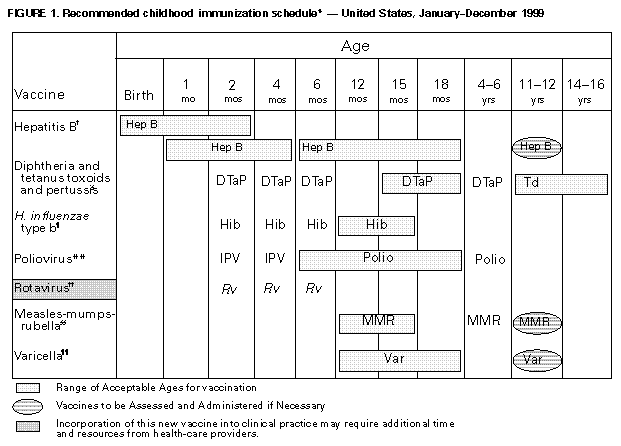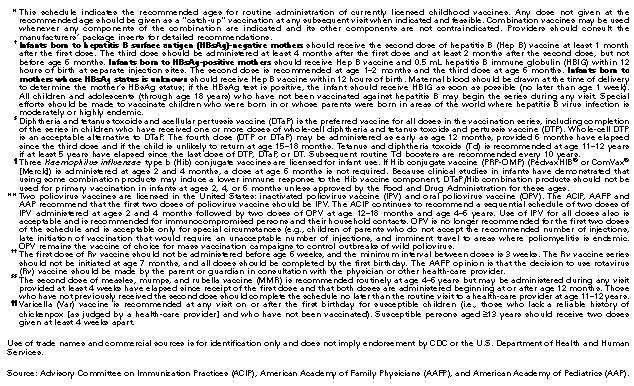 |
|
|
|
|
|
|
| ||||||||||
|
|
|
|
|
|
|
||||
| ||||||||||
|
|
|
|
|
Persons using assistive technology might not be able to fully access information in this file. For assistance, please send e-mail to: mmwrq@cdc.gov. Type 508 Accommodation and the title of the report in the subject line of e-mail. Notice to Readers Recommended Childhood Immunization Schedule -- United States, 1999Each year, CDC's Advisory Committee on Immunization Practices (ACIP) reviews the recommended childhood immunization schedule to ensure it remains current with changes in manufacturers' vaccine formulations, revised recommendations for the use of licensed vaccines, and recommendations for newly licensed vaccines. This report presents the recommended childhood immunization schedule for 1999 (Figure_1 and Figure_1C) and explains the changes that have occurred since January 1998. Since the publication of the recommended childhood immunization schedule in January 1998 (1), the ACIP, the American Academy of Family Physicians (AAFP), and the American Academy of Pediatrics (AAP) have narrowed the recommended options for the use of poliovirus vaccine and have endorsed the use of the newly licensed oral, tetravalent rotavirus vaccine. In addition, recommendations were revised or clarified for the use of hepatitis B vaccine in infants born to hepatitis B surface antigen (HBsAg)-negative mothers, the use of diphtheria and tetanus toxoids and acellular pertussis vaccine (DTaP), and the use of Haemophilus influenzae type b (Hib) conjugate and DTaP combination vaccines for infants aged 2, 4, and 6 months. Detailed recommendations for the use of vaccines are available from the manufacturers' package inserts, ACIP statements on specific vaccines, and the 1997 Red Book (2). ACIP statements for each recommended childhood vaccine may be viewed, downloaded, and printed at CDC's National Immunization Program World-Wide Web site, http://www.cdc.gov/nip. Inactivated Poliovirus Vaccine for First Two Doses As a result of progress in the global eradication of poliomyelitis, the need for further reductions in the risk for acquiring vaccine-associated paralytic polio, and the acceptance of inactivated poliovirus vaccine (IPV) by parents and physicians, the ACIP, AAFP, and AAP recommend IPV for the first two doses of poliovirus vaccine for routine childhood vaccination. The ACIP continues to recommend a sequential schedule of two doses of IPV administered at ages 2 and 4 months, followed by two doses of oral poliovirus vaccine (OPV) at ages 12-18 months and 4-6 years. The administration of IPV for all four poliovirus vaccine doses also is acceptable and is recommended for immunocompromised persons and their household contacts. OPV is no longer recommended for the first two doses of the schedule and is acceptable only for special circumstances (e.g., vaccination of children whose parents do not accept the recommended sequential schedule, late initiation of vaccination that would require an unacceptable number of injections, and imminent travel to countries where polio is endemic). OPV remains the vaccine of choice for mass vaccination campaigns to control outbreaks of wild poliovirus. Introduction of Rotavirus Vaccine On August 31, an oral, tetravalent vaccine for rotavirus (RotaShield {Registered}, Wyeth-Lederle Pediatrics and Vaccines, Inc., Philadelphia, Pennsylvania) * was licensed by the Food and Drug Administration (FDA) to prevent rotavirus gastroenteritis among infants and children. Rotavirus vaccine is administered as an oral formulation to infants at ages 2, 4, and 6 months, and the three-dose series should be completed by the first birthday. The vaccine also is approved by the ACIP for inclusion in the Vaccines for Children Program (VFC), and it will be available for distribution through VFC after a supply contract is arranged. Rotavirus vaccine has been shaded and italicized on the schedule chart to indicate that the ACIP, AAFP, and AAP recognize that the incorporation of this vaccine into clinical practice may require additional time and resources from health-care providers. Recombivax HB {Registered} Hepatitis B Vaccine for Persons Aged 0-19 Years On August 27, the Merck Vaccine Division (Merck and Co., Inc., West Point, Pennsylvania) discontinued production and distribution of the 2.5 ug/0.5 mL pediatric dose of Recombivax HB {Registered} hepatitis B vaccine, which was licensed by FDA for infants of HBsAg-negative mothers and children aged less than 11 years. The 5 ug/0.5 mL dose of Recombivax HB {Registered} is now indicated for all vaccinees aged 0-19 years regardless of the mother's HBsAg status. The change was made to simplify the dosing of Recombivax HB {Registered} and eliminate potential confusion when determining the correct dose of hepatitis B vaccine. In addition to receiving the hepatitis B vaccine series, infants born to HBsAg-positive mothers also should receive 0.5 mL of hepatitis B immune globulin within 12 hours of birth at separate injection sites. Infants born to HBsAg-negative mothers or children who received one or two doses of the 2.5 ug/0.5 mL dose of Recombivax HB {Registered} may complete the hepatitis B vaccination series with either the 2.5 ug/0.5 mL or the 5.0 ug/0.5 mL dose. Children who have completed the hepatitis B vaccination series with the 2.5 ug/0.5 mL dose do not require revaccination. The standard adult dose for Recombivax HB {Registered} remains 10 ug/1.0 mL. The standard doses for the other licensed hepatitis B vaccine (Engerix B {Registered}, SmithKline Beecham, Pittsburgh, Pennsylvania) remain unchanged. For the purposes of completing the hepatitis B vaccine series and achieving complete vaccination for hepatitis B, the two licensed hepatitis B vaccines are interchangeable when administered in doses recommended by the manufacturers. Diphtheria and Tetanus Toxoids and Acellular Pertussis Vaccines Preferred DTaP is the recommended vaccine for primary vaccination against diphtheria, tetanus, and pertussis. This change makes DTaP the preferred vaccine formulation for all doses in the vaccination series. Whole-cell diphtheria and tetanus toxoids and pertussis vaccine remains an acceptable alternative when DTaP is not available. Hib Conjugate and DTaP Combination Vaccines Not for Infants Combination vaccines containing Hib conjugate vaccine and DTaP are licensed only for use in children aged 15-18 months. Because studies in infants have demonstrated that using one of these combination products may induce a lower immune response to the Hib component (3), DTaP/Hib combination products should not be used for primary vaccination in infants aged 2, 4, or 6 months (4). References
1998. MMWR 1998;47:8-12. 2. American Academy of Pediatrics. Active and passive immunization. In: Peter G, ed. 1997 Red book: report of the Committee on Infectious Diseases. 24th ed. Elk Grove Village, Illinois: American Academy of Pediatrics 1997:1-71. 3. Edwards K, Decker MD. Combination vaccines consisting of acellular pertussis vaccines. Pediatr Infect Dis J 1997;16:S97-S102. 4. CDC. Unlicensed use of combination of Haemophilus influenzae type b conjugate vaccine and diphtheria and tetanus toxoid and acellular pertussis vaccine for infants. MMWR 1998;47:787. * Use of trade names and commercial sources is for identification only and does not imply endorsement by CDC or the U.S. Department of Health and Human Services. Figure_1  Return to top. Figure_1C  Return to top. Disclaimer All MMWR HTML versions of articles are electronic conversions from ASCII text into HTML. This conversion may have resulted in character translation or format errors in the HTML version. Users should not rely on this HTML document, but are referred to the electronic PDF version and/or the original MMWR paper copy for the official text, figures, and tables. An original paper copy of this issue can be obtained from the Superintendent of Documents, U.S. Government Printing Office (GPO), Washington, DC 20402-9371; telephone: (202) 512-1800. Contact GPO for current prices. **Questions or messages regarding errors in formatting should be addressed to mmwrq@cdc.gov.Page converted: 01/14/99 |
|||||||||
This page last reviewed 5/2/01
|